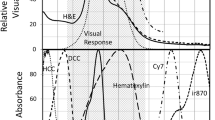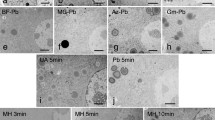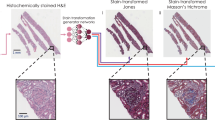Abstract
WORK in this Department, to be published elsewhere, has shown that several histological methods for the demonstration of mucin depend for their selectivity on the use of cations of large size. Thus alcian blue, with a molecular weight of about 1,341 (ref. 1), is almost specific for acid mucins, being apparently unable to enter other, more dense, basophilic structures. The dialysed iron method2 similarly depends on the use of large particles (colloidal ferric hydroxide), while in Southgate's mucicarmine the small carmine molecule is probably adsorbed on to colloidal aluminium hydroxide.
This is a preview of subscription content, access via your institution
Access options
Subscribe to this journal
Receive 51 print issues and online access
$199.00 per year
only $3.90 per issue
Buy this article
- Purchase on Springer Link
- Instant access to full article PDF
Prices may be subject to local taxes which are calculated during checkout
Similar content being viewed by others
References
Gurr, E., Encyclopædia of Microscopic Stains (Leonard Hill (Books), Ltd., London, 1960).
Hale, C. W., Nature, 157, 802 (1946).
Lison, L., Quart. J. Micro. Sci., 96, 227 (1955).
Kurnick, N. B., Int. Rev. Cytol., 4, 221 (1955).
Baker, J. R., Principles of Biological Microtechnique (Methuen and Co., Ltd., London, 1958).
Author information
Authors and Affiliations
Rights and permissions
About this article
Cite this article
GOLDSTEIN, D. Mechanism of Differential Staining of Nucleic Acids. Nature 191, 407–408 (1961). https://doi.org/10.1038/191407a0
Issue Date:
DOI: https://doi.org/10.1038/191407a0
This article is cited by
-
Victoria blue B — a nuclear stain for cytology
Histochemistry (1988)
-
Quantitation of dye binding by cell monolayers in a microtiter system
The Histochemical Journal (1986)
-
The effect of pH on Alcian Blue staining of epithelial acid glycoproteins. I. Sialomucins and sulphomucins (singly or in simple combinations)
The Histochemical Journal (1973)
-
Measurements of the affinities of basic and ?mordant? dyes for various tissue substrates
Histochemie (1973)
-
Histochemistry of Alcian blue
Histochemie (1972)
Comments
By submitting a comment you agree to abide by our Terms and Community Guidelines. If you find something abusive or that does not comply with our terms or guidelines please flag it as inappropriate.



